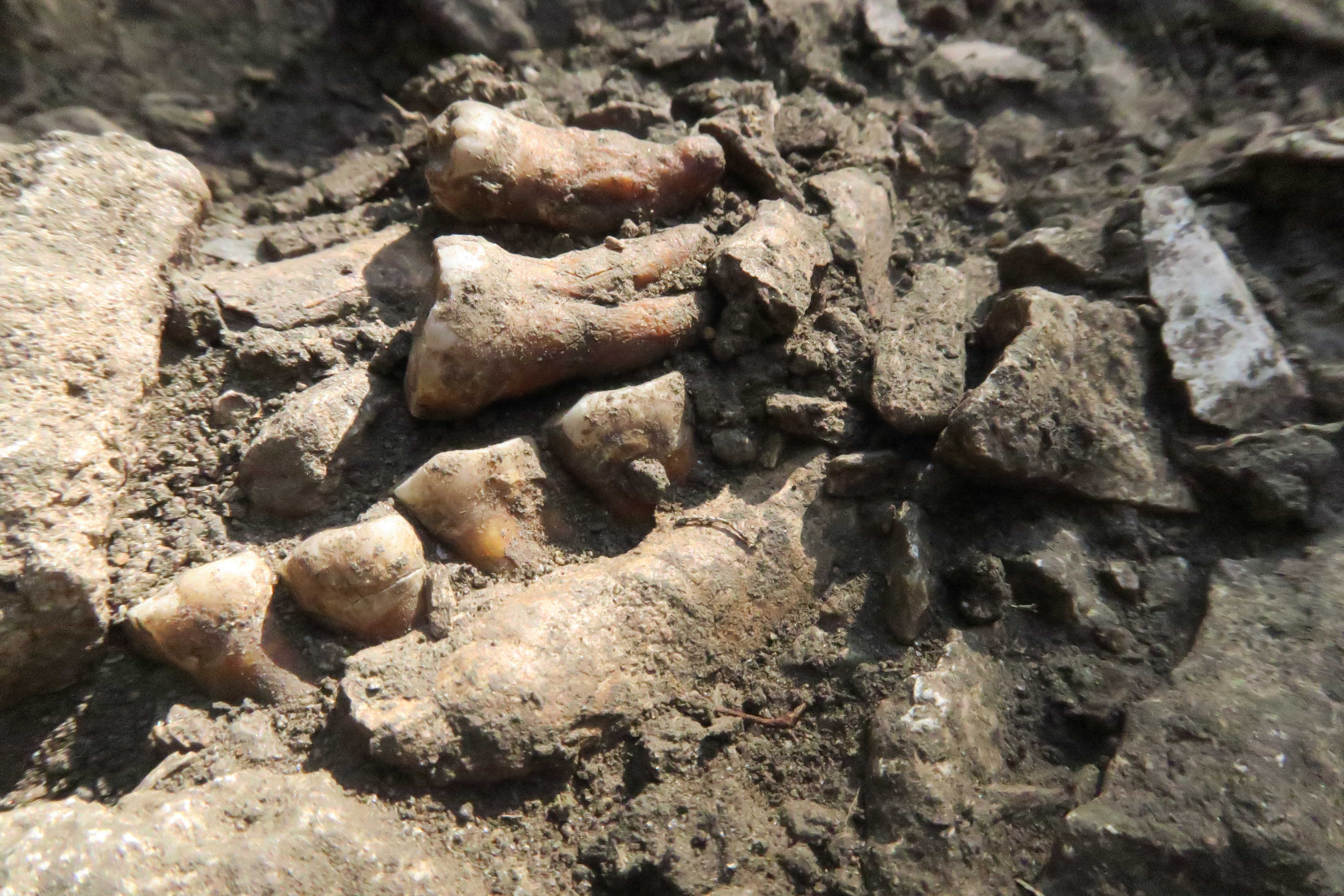Teeth
An Ice Age Infant’s 17,000-Year-Old DNA Reveals He Had Dark Skin and Blue Eyes
The baby boy’s recovered genome suggests he’s related to a famous Ice Age population
Rare Jaw Fossils Discovered in Texas Shed Light on a 20-Foot-Long Mosasaur
Unearthed last year, the remains could reveal new information on the extinct sea reptile, which crushed mollusks and shelled creatures with its large, round teeth
Ancient DNA Reveals Neanderthal Group Was Isolated for 50,000 Years
A new study, based on the remains of a Neanderthal nicknamed Thorin, is shaking up what archaeologists long thought about these early humans in Europe
‘Fearsome’ Saber-Toothed Cats Needed Their Baby Teeth and Mommies, Too
According to new research, two sets of sabers and unusual lower jaw anatomy show that the saber-toothed cat Smilodon fatalis delayed adulting with a long weaning period
Fossils Shed New Light on Small 'Hobbit-Like' Humans That Lived on a Remote Island
Two teeth and a small adult arm bone found in Indonesia suggest the ancestors of Homo floresiensis were even shorter than scientists previously thought
Komodo Dragons Have Iron-Coated Teeth, Study Finds
New research provides the first evidence of the adaptation in a carnivorous reptile, and it might hold clues to understanding the teeth of dinosaurs
These Massive, Extinct Salmon Had Spiky Teeth Like a Warthog's Tusks
For decades, scientists thought the teeth pointed downward, similar to those of a saber-toothed cat, but now they believe the fish's chompers jutted out sideways
Dentist Discovers Human-Like Jawbone and Teeth in a Floor Tile at His Parents' Home
Scientists are planning to study the specimen, embedded in travertine from western Turkey, in hopes of dating and identifying it
Vikings May Have Used Body Modification as a 'Sign of Identification'
A recent study analyzes Scandinavian examples of filed teeth and elongated skulls dating to the Viking Age
Why Isn't Dental Health Considered Primary Medical Care?
Ailments of the mouth can put the body at risk for a slew of other ills, yet dentistry is often siloed
What Centuries-Old Shark Teeth Reveal About Brazil's Ocean
Researchers examined the remnants of a 13th-century fishing site to get a picture of how the marine ecosystem has changed
Winston Churchill Wore False Teeth to Deliver Historic Wartime Speeches. Now, They're for Sale
The British prime minister likely acquired the custom gold-mounted dentures around the beginning of World War II
Construction Workers Discover Indigenous Burial Ground in Toronto
Researchers who investigated the site estimate that it's about 700 years old
Early Primates May Have Feasted on Soft, Sweet Fruits
An analysis of more than 400 fossilized teeth suggests the creatures weren't eating many seeds, nuts or other hard foods
These Large, Flesh-Eating Lampreys Lived 160 Million Years Ago
Paleontologists in China recently unearthed the fossilized remains of two new species of lamprey, a group of jawless fish that dates back 360 million years
Early Europeans Ate Seaweed for Thousands of Years
Researchers found biomarkers of seaweed and other aquatic plants in samples of dental plaque
These Prehistoric Dolphins Had Tusk-Like Teeth
The animals likely thrashed their heads back and forth to injure or stun prey with their unusual, horizontal teeth
Woman Finds Mastodon Tooth on California Beach
The photos she shared set off a search for the fossil, which she had left behind. Now, scientists have the tooth, just the third of its kind found locally
Male Woolly Mammoths Had Testosterone-Fueled Aggressive Episodes
By studying preserved tusks, scientists suggest the mammals experienced a yearly condition known as musth, like male elephants do today
What Secrets Lie Beneath This 17th-Century French Aristocrat's Smile?
New research suggests noblewoman Anne d’Alégre used gold wire to keep her decaying teeth in place
Page 1 of 5
:focal(847x637:848x638)/https://tf-cmsv2-smithsonianmag-media.s3.amazonaws.com/filer_public/49/a0/49a04cd4-ff2c-4863-abf0-ddab5e58b61d/screen_shot_2024-10-21_at_114341_am.jpeg)
:focal(425x320:426x321)/https://tf-cmsv2-smithsonianmag-media.s3.amazonaws.com/filer_public/21/4f/214fb752-d077-486e-a6b2-dca284c50163/globidens-alabamaensis.jpeg)

:focal(2289x1482:2290x1483)/https://tf-cmsv2-smithsonianmag-media.s3.amazonaws.com/filer_public/46/f9/46f9d007-90c0-458a-a48b-d670a979d6c6/gettyimages-1041335158.jpg)
:focal(750x500:751x501)/https://tf-cmsv2-smithsonianmag-media.s3.amazonaws.com/filer_public/06/08/06083a62-fc31-46a0-a2c1-981fa9ade827/untitled_design_15.png)
:focal(2429x1619:2430x1620)/https://tf-cmsv2-smithsonianmag-media.s3.amazonaws.com/filer_public/4f/e6/4fe6bcc6-7ff9-4947-9f62-464712cff3bb/gettyimages-2123610440.jpg)
:focal(593x507:594x508)/https://tf-cmsv2-smithsonianmag-media.s3.amazonaws.com/filer_public/fb/4f/fb4fa92d-5623-4ba5-b7cb-9e3402486a48/spike_tooth_profile_press_ray_troll.jpg)
:focal(540x360:541x361)/https://tf-cmsv2-smithsonianmag-media.s3.amazonaws.com/filer_public/05/c5/05c5b0c8-2e9b-410e-bd2b-44fa17b8eaaf/found-a-mandible-in-the-travertin-floor-at-my-parents-house-v0-6rxgyqsizluc1.jpeg)
:focal(1000x752:1001x753)/https://tf-cmsv2-smithsonianmag-media.s3.amazonaws.com/filer_public/56/aa/56aa76a2-51d9-4af2-82a8-79c9f6bb873d/viking.jpg)
:focal(800x602:801x603)/https://tf-cmsv2-smithsonianmag-media.s3.amazonaws.com/filer_public/bf/d2/bfd27527-fc66-4474-9bba-30835c2256a2/gettyimages-1269429519_web.jpg)
:focal(800x602:801x603)/https://tf-cmsv2-smithsonianmag-media.s3.amazonaws.com/filer_public/f7/4e/f74ef6fe-aa83-4a97-98b9-16c6ca5e87bb/header-uncropped_shark_web.jpg)
:focal(1411x1115:1412x1116)/https://tf-cmsv2-smithsonianmag-media.s3.amazonaws.com/filer_public/6a/97/6a976736-3821-4a4b-b9b6-ae2e1866dbf6/gettyimages-3268903.jpg)
:focal(640x482:641x483)/https://tf-cmsv2-smithsonianmag-media.s3.amazonaws.com/filer_public/7b/41/7b410c2a-28b0-4c9e-9351-334c93104e24/img_3523.jpeg)
:focal(700x527:701x528)/https://tf-cmsv2-smithsonianmag-media.s3.amazonaws.com/filer_public/dc/de/dcde6ff1-e24d-4685-9dff-1368b7a66262/untitled_design.jpg)
:focal(1280x719:1281x720)/https://tf-cmsv2-smithsonianmag-media.s3.amazonaws.com/filer_public/4d/bc/4dbcf28c-1a83-4a52-9974-af75be680f0d/2.jpeg)
:focal(2900x1933:2901x1934)/https://tf-cmsv2-smithsonianmag-media.s3.amazonaws.com/filer_public/d3/44/d344e243-9e53-4d20-acdf-bb30d305bd8d/gettyimages-1407702607.jpg)
:focal(400x251:401x252)/https://tf-cmsv2-smithsonianmag-media.s3.amazonaws.com/filer_public/9e/95/9e95aaf4-d0c2-4406-8768-907e62977678/nihohaa_matakoi_resized.jpg)
:focal(768x1024:769x1025)/https://tf-cmsv2-smithsonianmag-media.s3.amazonaws.com/filer_public/82/68/8268c25a-8093-445e-aa6b-3241d13d5ef5/346318547_3508622632742112_6607967982096252811_n.jpg)
:focal(750x564:751x565)/https://tf-cmsv2-smithsonianmag-media.s3.amazonaws.com/filer_public/99/7d/997d1070-82fb-44ec-bf37-87519772bd9b/new-tusk-analysis-techniques-reveal-surging-testosterone-in-male-woolly-mammoths-1-1.jpeg)
:focal(700x527:701x528)/https://tf-cmsv2-smithsonianmag-media.s3.amazonaws.com/filer_public/59/a8/59a874ad-2a96-4d77-a01f-287e03acb5a7/anne.png)